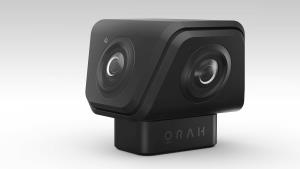New Camera Live Streams Virtual Reality
VideoStitch, a Sunnyvale, CA-based company that creates 360-degree video software and hardware, has launched a new virtual reality camera that can live stream to online video platforms and VR headsets such as the Oculus Rift.
The Orah 4i is a singular, 4K camera designed for high-quality live streaming. It features four fish-eye lenses, two angled up and two angled down, and a compact computer called a “stitching box” that provides 120 GB of storage.
The price of the Orah 4i is $1,795 through the end of the month. That’s considerably less than its competitors in the market — namely Canon’s EOS-1D X Mark II DSLR, priced at $6,000, or GoPro’s 16-part Odyssey VR camera, which costs $15,000.
After April 30, the price of the Orah 4i will increase incrementally until it reaches $3,595, the manufacturer’s suggested retail price.
Online purchases will be considered pre-orders. The camera, stitching box and cables are anticipated to ship out this summer.

The Orah 4i is a new camera that has four lenses and can live stream virtual reality to sites and devices.
Nicolas Burtey, CEO and founder of VideoStitch, said last week in a press statement: “Until today, a live VR video production workflow relied on an array of small cameras put together on a holder. Videographers then dealt with multiple cables, power supplies and a variety of small hardware components. Orah removes these inefficiencies and numerous points of failure and lets them focus on what really matters to them for creating compelling content. We have developed a solution that streams 4K resolution, live, virtual reality video to headsets – all with the push of a button.”
The Orah 4i will also feature “ambisonic” 3D sound-capture capabilities that will enable the viewer of the live stream to locate the origin of the sound source with a VR headset, purportedly bringing the feeling of immersion to a new level. The live stream can be uploaded onto a site such as littlstar.com or an app such as Woozza, then downloaded via a VR headset, Burtey said.
Virtual reality is a platform that is gaining interest because of the recent delivery of much-anticipated headsets to customers. At the end of March, Oculus announced that it had begun shipping its Oculus Rift headsets to those who initially invested via Kickstarter. Pre-ordered Rifts were expected to ship out in early April.
According to the 2015 K-12 Edition of the New Media Consortium Horizon Report, wearable technology, including VR headsets, is one of the most important developments in K-12 education technology over the next four to five years.
Educators have cited the technology as particularly “promising” for providing context-enabled learning, such as “immersive field trips” and experiencing biology concepts.
“Education is one of our main purposes,” CEO Burtley said in an interview. “We want to reach the youth audience. You could live stream classes or lectures. We’re already working with top schools in the United States, so they can live stream key moments, such as talks from professors.”
Burtley said VideoStitch would offer volume discounts if a school wanted to buy multiple Orah 4i cameras.
While virtual reality offers promising new possibilities, it “will only become a sustainable industry with massive, high-quality content production,” VideoStitch said in its press statement. “Orah unleashes the potential of the market by directly addressing this critical issue.”
The Orah 4i is surprisingly compact, sizing up at 3.1 by 2.7 by 2.5 inches, and weighing 17 ounces. It is encased in 100 percent anodized precipitation-hardened aluminum, and can easily fit on a standard camera mount.
The stitching box uses Intel and Nvidia processors, has inputs for a microphone and headset, and sports four USB 3.0 ports and two USB 2.0 ports. It also has Bluetooth, WiFi and LAN capabilities.
The entire setup can be stashed in a backpack or briefcase.
VideoStitch was founded in 2012 in Paris. It moved its headquarters to the San Francisco Bay Area, but maintains an office in France.
About the Author
Richard Chang is associate editor of THE Journal. He can be reached at [email protected].